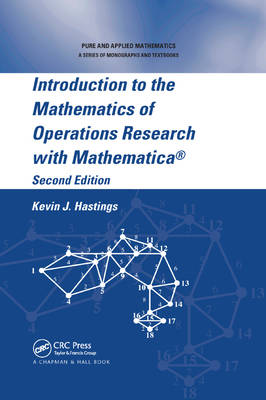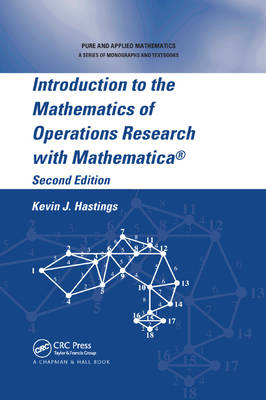
Door een staking bij bpost kan je online bestelling op dit moment iets langer onderweg zijn dan voorzien. Dringend iets nodig? Onze winkels ontvangen jou met open armen!
- Afhalen na 1 uur in een winkel met voorraad
- Gratis thuislevering in België vanaf € 30
- Ruim aanbod met 7 miljoen producten
Door een staking bij bpost kan je online bestelling op dit moment iets langer onderweg zijn dan voorzien. Dringend iets nodig? Onze winkels ontvangen jou met open armen!
- Afhalen na 1 uur in een winkel met voorraad
- Gratis thuislevering in België vanaf € 30
- Ruim aanbod met 7 miljoen producten
Zoeken
Introduction to the Mathematics of Operations Research with Mathematica(r)
Kevin J Hastings
Paperback | Engels
€ 85,45
+ 170 punten
Omschrijving
The breadth of information about operations research and the overwhelming size of previous sources on the subject make it a difficult topic for non-specialists to grasp. Fortunately, Introduction to the Mathematics of Operations Research with Mathematica(R), Second Edition delivers a concise analysis that benefits professionals in operations research and related fields in statistics, management, applied mathematics, and finance. The second edition retains the character of the earlier version, while incorporating developments in the sphere of operations research, technology, and mathematics pedagogy. Covering the topics crucial to applied mathematics, it examines graph theory, linear programming, stochastic processes, and dynamic programming. This self-contained text includes an accompanying electronic version and a package of useful commands. The electronic version is in the form of Mathematica notebooks, enabling you to devise, edit, and execute/reexecute commands, increasing your level of comprehension and problem-solving. Mathematica sharpens the impact of this book by allowing you to conveniently carry out graph algorithms, experiment with large powers of adjacency matrices in order to check the path counting theorem and Markov chains, construct feasible regions of linear programming problems, and use the "dictionary" method to solve these problems. You can also create simulators for Markov chains, Poisson processes, and Brownian motions in Mathematica, increasing your understanding of the defining conditions of these processes. Among many other benefits, Mathematica also promotes recursive solutions for problems related to first passage times and absorption probabilities.
Specificaties
Betrokkenen
- Auteur(s):
- Uitgeverij:
Inhoud
- Aantal bladzijden:
- 588
- Taal:
- Engels
Eigenschappen
- Productcode (EAN):
- 9780367390785
- Verschijningsdatum:
- 19/09/2019
- Uitvoering:
- Paperback
- Formaat:
- Trade paperback (VS)
- Afmetingen:
- 150 mm x 229 mm
- Gewicht:
- 839 g

Alleen bij Standaard Boekhandel
+ 170 punten op je klantenkaart van Standaard Boekhandel
Beoordelingen
We publiceren alleen reviews die voldoen aan de voorwaarden voor reviews. Bekijk onze voorwaarden voor reviews.











